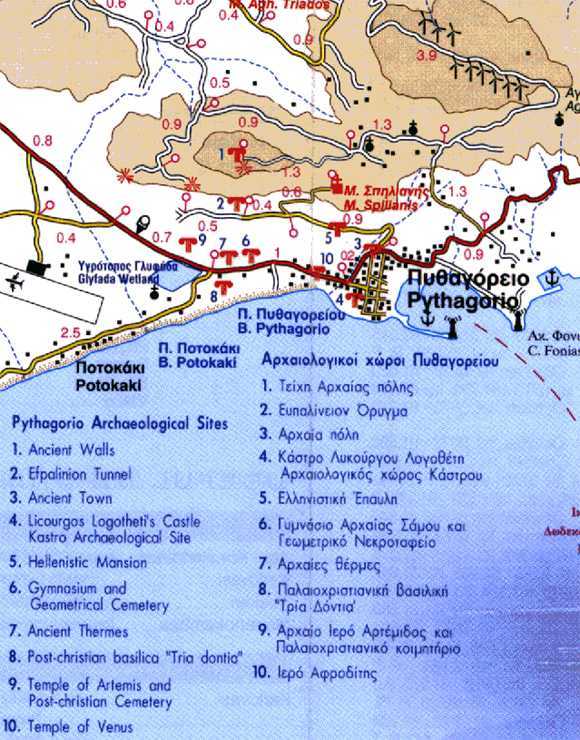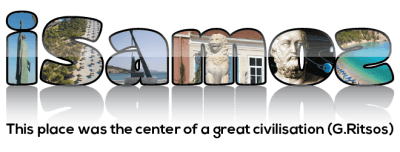The ancient city is located on the South-eastern coast of the island, where today’s Pythagorion (named after the most important off-spring of Samos, the mathematician and philosopher, Pythagoras), lies. Its exceptional position on significant trade routes quickly attracted the attention of many.
The oldest relics of habitation which were found during excavations on the hill of the Castle of Logothetis, are dated to the Latter Neolithic Age (end of the 4th Millennium BC.) and continue in consecutive layers up to the Early Bronze Age (2800-1900 BC.). These findings show relations to the civilizations of Saliagos and Grotas-Pilos.
Few findings, representative of The Mycenae Age are also present in the city. Early-Geometric and Geometric Age remains of habitation, mainly tombs, have been found in the area of the ancient Agora and throughout the city. Tombs and graves, which have recently been excavated by M. Viglaki in the area of the ancient Gymnasium, present great interest. The fact that these tombs most probably remained visible, and were respected within the boundaries of the city, until the construction of the Gymnasium-Palestra (wrestling) complex, following the return of the exiled inhabitants of Samos (322 BC.), possibly indicates an ancestor-worship connected to the race of the “Geomores”, the former owners of the land – the first Ionian settlers.
The great technical works from the heyday of Samos, which Herodotus refers to with such admiration, are preserved to this day: The great temple of the goddess Hera, The ‘Amfistomou Orygma” (Two-entranced Tunnel), better known as The Tunnel of Efpalinos and the “Choma en thalassii” (the ancient pier of Pythagorion), are the great works of ancient Samos. Alongside these great accomplishments of antiquity are the impressive city walls, which are directly connected to them.
The ancient city is located on the South-eastern coast of the island, where today’s Pythagorion (named after the most important off-spring of Samos, the mathematician and philosopher, Pythagoras), lies. Its exceptional position on significant trade routes quickly attracted the attention of many. The oldest relics of habitation which were found during excavations on the hill of the Castle of Logothetis, are dated to the Latter Neolithic Age (end of the 4th Millennium BC.) and continue in consecutive layers up to the Early Bronze Age (2800-1900 BC.). These findings show relations to the civilizations of Saliagos and Grotas-Pilos. Few findings, representative of The Mycenae Age are also present in the city. Early-Geometric and Geometric Age remains of habitation, mainly tombs, have been found in the area of the ancient Agora and throughout the city. Tombs and graves, which have recently been excavated by M. Viglaki in the area of the ancient Gymnasium, present great interest. The fact that these tombs most probably remained visible, and were respected within the boundaries of the city, until the construction of the Gymnasium-Palestra (wrestling) complex, following the return of the exiled inhabitants of Samos (322 BC.), possibly indicates an ancestor-worship connected to the race of the “Geomores”, the former owners of the land – the first Ionian settlers. The great technical works from the heyday of Samos, which Herodotus refers to with such admiration, are preserved to this day: The great temple of the goddess Hera, The ‘Amfistomou Orygma” (Two-entranced Tunnel), better known as The Tunnel of Efpalinos and the “Choma en thalassii” (the ancient pier of Pythagorion), are the great works of ancient Samos. Alongside these great accomplishments of antiquity are the impressive city walls, which are directly connected to them. On the map you can see the ancient city of Pythagorion. In the annotation the archeological sites have been marked. 
 iSamos.gr Η ενημερωτική σελίδα της Σάμου! Εξερευνήστε τη Σάμο, τις παραλίες της, τη φύση της, τις ομορφιές της. Διαβάστε την ιστορία της Σάμου
iSamos.gr Η ενημερωτική σελίδα της Σάμου! Εξερευνήστε τη Σάμο, τις παραλίες της, τη φύση της, τις ομορφιές της. Διαβάστε την ιστορία της Σάμου

